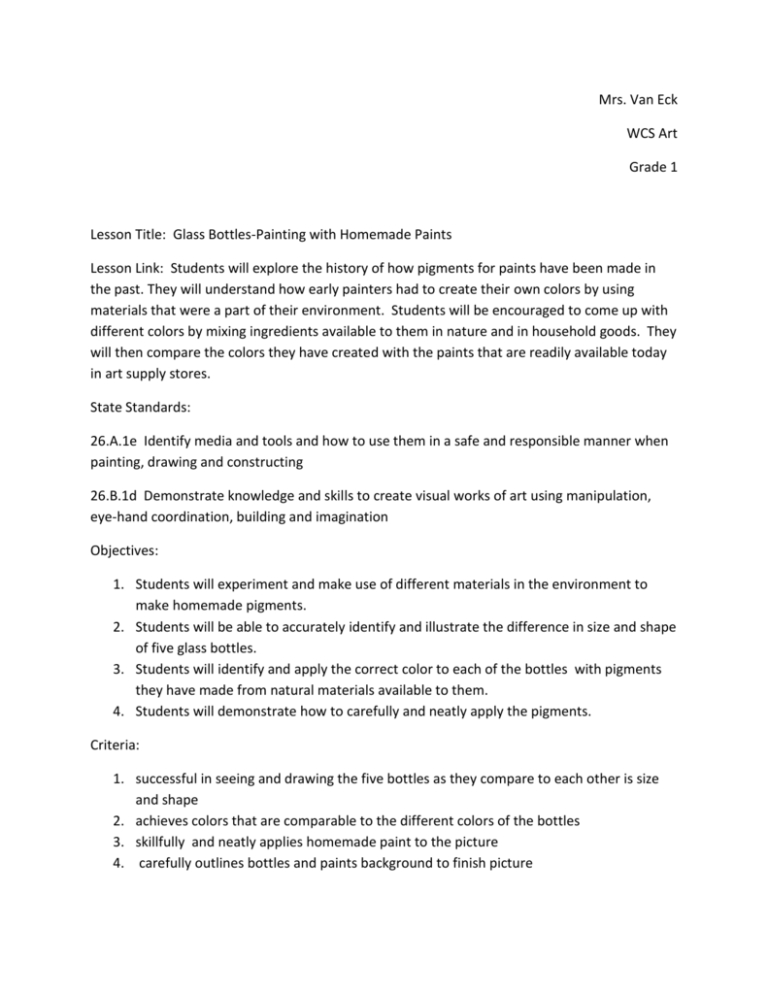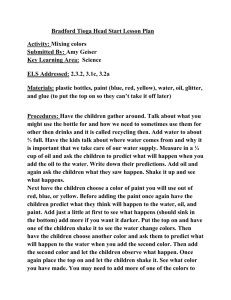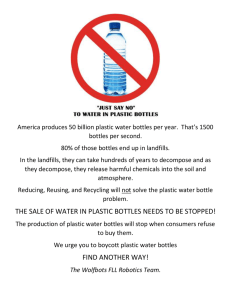Mrs. Van Eck WCS Art Grade 1 Lesson Title: Glass Bottles
advertisement

Mrs. Van Eck WCS Art Grade 1 Lesson Title: Glass Bottles-Painting with Homemade Paints Lesson Link: Students will explore the history of how pigments for paints have been made in the past. They will understand how early painters had to create their own colors by using materials that were a part of their environment. Students will be encouraged to come up with different colors by mixing ingredients available to them in nature and in household goods. They will then compare the colors they have created with the paints that are readily available today in art supply stores. State Standards: 26.A.1e Identify media and tools and how to use them in a safe and responsible manner when painting, drawing and constructing 26.B.1d Demonstrate knowledge and skills to create visual works of art using manipulation, eye-hand coordination, building and imagination Objectives: 1. Students will experiment and make use of different materials in the environment to make homemade pigments. 2. Students will be able to accurately identify and illustrate the difference in size and shape of five glass bottles. 3. Students will identify and apply the correct color to each of the bottles with pigments they have made from natural materials available to them. 4. Students will demonstrate how to carefully and neatly apply the pigments. Criteria: 1. successful in seeing and drawing the five bottles as they compare to each other is size and shape 2. achieves colors that are comparable to the different colors of the bottles 3. skillfully and neatly applies homemade paint to the picture 4. carefully outlines bottles and paints background to finish picture Teacher Resources: “Marguerite makes a Book” by Bruce Roberston Colored glass bottles Ingredients for mixing pigments: spices, coffee, tea, leaves, vinegar, berries, vegetables, juice Materials: 8” x 12” water color sheets Pencils Paint brushes Fine point sharpies Introduction: Teacher will read “Marguerite Makes a Book” which describes how books were once handmade and pigments for painting in the books were bought at the apothecary. Teacher will ask, “What are some of the materials that could have been used for making different pigments both then and now? How do these pigments compare to the paints that we use today” Day 1 Teacher will display five colored glass bottles and ask class to compare the differences in the shapes and sizes of them. Teacher will demonstrate how to draw the different bottles, starting with an ellipse. Class will draw along with the teacher on practice paper. Teacher will explain how each bottle has highlights on it, places where the light bounces off of it and makes a white shape. Students will identify the location and shape of the highlights on each of the bottles and color them in with a white crayon. Days 2-3 Teacher will ask the class to brainstorm on what natural ingredients could be used to mix the five different colors for painting the bottles and then display a variety of them to experiment with. Class will observe as teacher mixes several different combinations to create different colors. Class will offer suggestions and help with the mixing and then testing of the colors on scratch paper. Students will decide which ingredients to use and then paint the bottles with them. They can layer the paint in areas where they want a darker value. They will paint right over the white highlight as the crayon will resist the paint. Day 4 Students will use fine point sharpie to outline the bottles. Class will critique how the paintings turned out and compare the difference between the colors that were handmade and store bought paint. Reflections: The best ingredients to mix the colors were: turmeric for the yellow bottle, cooked red beet juice for the red bottle, a variety of greens and spinach for the green bottle, crushed blueberries for the blue bottle, and a mixture of coffee, cinnamon and cocoa for the brown bottle. The students agreed that the handmade colors weren’t as vibrant or true to color as the store bought water colors that they usually use in class. They also commented on the different odors that came with the handmade paints. Mixing the handmade paints helped the students understand why the colors appeared as they did in some of the older historical paintings.








